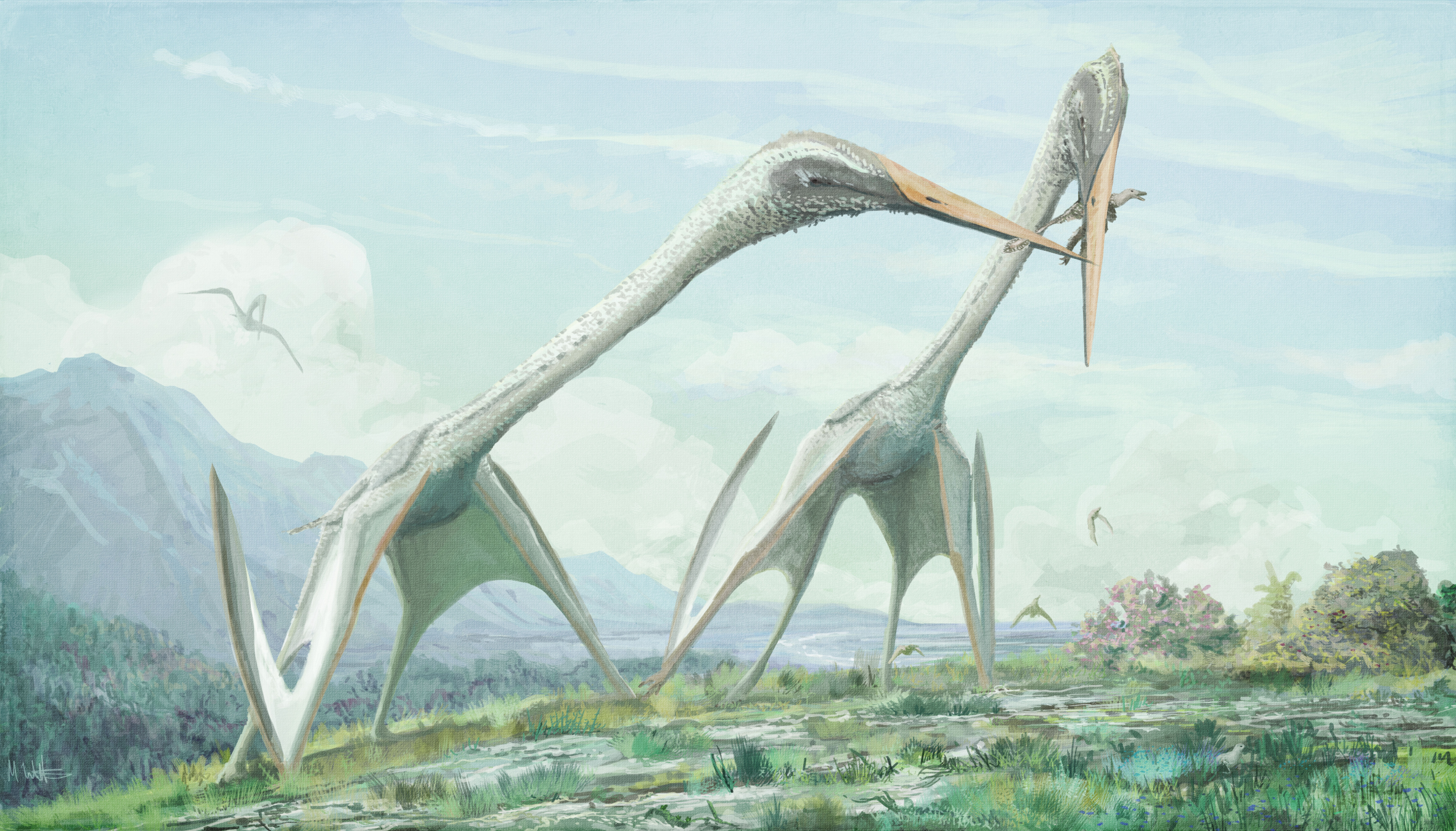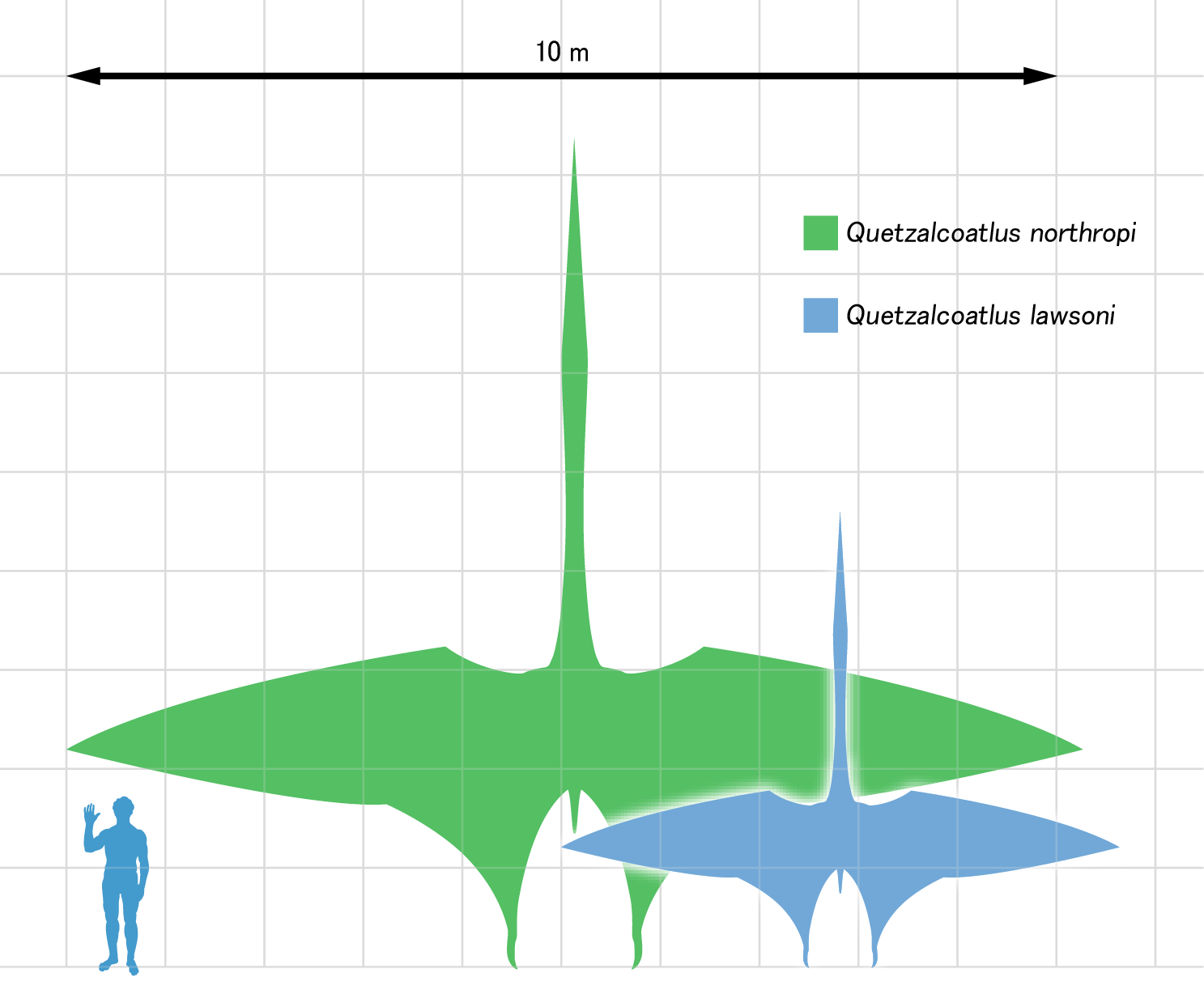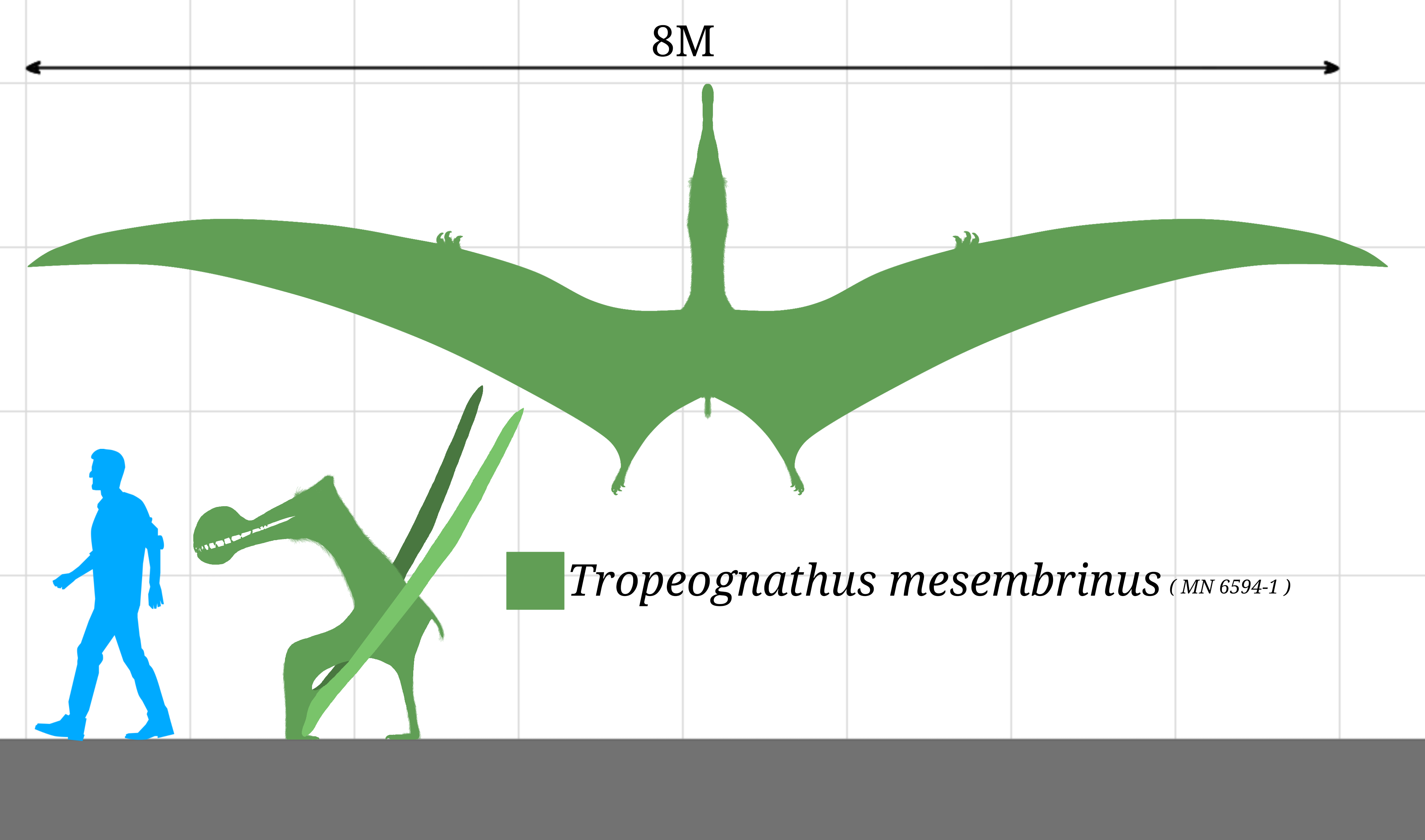Pterosaur size on:
[Wikipedia]
[Google]
[Amazon]

 This is a list of pterosaurs with estimated maximum wingspan of more than 5
This is a list of pterosaurs with estimated maximum wingspan of more than 5
 Some species of pterosaurs grew to very large sizes and this has implications for their capacity for flight. Many pterosaurs were small but the largest had wingspans which exceeded . The largest of these are estimated to have weighed . For comparison, the
Some species of pterosaurs grew to very large sizes and this has implications for their capacity for flight. Many pterosaurs were small but the largest had wingspans which exceeded . The largest of these are estimated to have weighed . For comparison, the
Pterosaur
Pterosaurs (; from Greek ''pteron'' and ''sauros'', meaning "wing lizard") is an extinct clade of flying reptiles in the order, Pterosauria. They existed during most of the Mesozoic: from the Late Triassic to the end of the Cretaceous (228 ...
s included the largest flying animals ever to have lived. They are a clade of prehistoric archosaurian reptiles closely related to dinosaur
Dinosaurs are a diverse group of reptiles of the clade Dinosauria. They first appeared during the Triassic period, between 243 and 233.23 million years ago (mya), although the exact origin and timing of the evolution of dinosaurs is t ...
s. Species among pterosaurs occupied several types of environments, which ranged from aquatic to forest
A forest is an area of land dominated by trees. Hundreds of definitions of forest are used throughout the world, incorporating factors such as tree density, tree height, land use, legal standing, and ecological function. The United Nations' ...
ed. Below are the lists that comprise the smallest and the largest pterosaurs known .

Smallest pterosaurs
The smallest known pterosaur is '' Nemicolopterus'' with a wingspan of about . The specimen found may be a juvenile or a subadult, however, and adults may have been larger. ''Anurognathus
''Anurognathus'' is a genus of small pterosaur that lived during the Late Jurassic period ( Tithonian stage). ''Anurognathus'' was first named and described by Ludwig Döderlein in 1923.Döderlein, L. (1923). "''Anurognathus Ammoni'', ein neue ...
'' is another small pterosaur, with a wingspan of and in body mass.
Pterosaurs with largest wingspan
 This is a list of pterosaurs with estimated maximum wingspan of more than 5
This is a list of pterosaurs with estimated maximum wingspan of more than 5 meter
The metre (British spelling) or meter (American spelling; see spelling differences) (from the French unit , from the Greek noun , "measure"), symbol m, is the primary unit of length in the International System of Units (SI), though its pref ...
s (16 feet
The foot ( : feet) is an anatomical structure found in many vertebrates. It is the terminal portion of a limb which bears weight and allows locomotion. In many animals with feet, the foot is a separate organ at the terminal part of the leg made ...
):
# '' Hatzegopteryx thambema''
#'' Quetzalcoatlus northopi''
# ''Cryodrakon
''Cryodrakon'' ("cold dragon") is a genus of azhdarchid pterosaur that lived during the Late Cretaceous period in what is now Canada. It contains a single species, ''Cryodrakon boreas'', recovered from the Dinosaur Park Formation.
Discovery an ...
boreas''
# Undescribed specimen from Mongolia
# ''Arambourgiania
''Arambourgiania'' is an extinct genus of azhdarchid pterosaur from the Late Cretaceous period (Maastrichtian stage) of Jordan, and possibly the United States.Harrell, T. Lynn Jr.; Gibson, Michael A.; Langston, Wann Jr. (2016). "A cervical ver ...
philadelphiae''
# '' Thanatosdrakon amaru''
# ''Tropeognathus
''Tropeognathus'' (meaning "keel jaw") is a genus of large pterosaurs from the late Early Cretaceous of South America. This genus is considered to be a member of the family Anhangueridae, however, several studies have also recovered it within a ...
mesembrinus''
# ''Geosternbergia
''Geosternbergia'' is an extinct genus of pteranodontid pterodactyloid pterosaur from the Late Cretaceous geological period of North America. ''Geosternbergia'' was one of the largest pterosaur genera, and had a wingspan of up to .
Discovery ...
maiseyi''
# '' Thapunngaka shawi''
# '' Pteranodon longiceps''
# ''Alanqa
''Alanqa'' is a genus of pterodactyloid pterosaur from the Late Cretaceous period (Cenomanian stage) of what is now the Kem Kem Beds of southeastern Morocco. The name ''Alanqa'' comes from the Arabic language, Arabic word العنقاء ''al-Anqa ...
saharica''
# ''Santanadactylus
''Santanadactylus'' (meaning "Santana Formation finger") was a genus of pterodactyloid pterosaur from the Albian-age Romualdo Member of the Upper Cretaceous Santana Formation, of Barra do Jardim, Araripe Plateau, Ceará State, Brazil. Four spec ...
araripensis'' Wellnhofer, P. (1991). ''The Illustrated Encyclopedia of Pterosaurs''. New York: Barnes and Noble Books. pp. 124. .
# ''Cearadactylus
''Cearadactylus'' is a genus of large anhanguerid pterodactyloid pterosaur from the Romualdo Formation of Brazil, South America. Fossil remains of ''Cearadactylus'' dated back to the Albian stage of the Early Cretaceous period, about 112 million ...
atrox''
The largest of non-pterodactyloid
Pterodactyloidea (derived from the Greek words ''πτερόν'' (''pterón'', for usual ''ptéryx'') "wing", and ''δάκτυλος'' (''dáktylos'') "finger" meaning "winged finger", "wing-finger" or "finger-wing") is one of the two traditional ...
pterosaurs as well as the largest Jurassic
The Jurassic ( ) is a geologic period and stratigraphic system that spanned from the end of the Triassic Period million years ago (Mya) to the beginning of the Cretaceous Period, approximately Mya. The Jurassic constitutes the middle period of ...
pterosaur was '' Dearc'', with an estimated wingspan between and . Only a fragmentary rhamphorhynchid
Rhamphorhynchidae is a group of early pterosaurs named after '' Rhamphorhynchus'', that lived in the Late Jurassic. The family Rhamphorhynchidae was named in 1870 by Harry Govier Seeley.Seeley, H.G. (1870). "The Orithosauria: An Elementary Study ...
specimen from Germany
Germany,, officially the Federal Republic of Germany, is a country in Central Europe. It is the second most populous country in Europe after Russia, and the most populous member state of the European Union. Germany is situated betwe ...
could be larger (184 % the size of the biggest ''Rhamphorhynchus
''Rhamphorhynchus'' (, from Ancient Greek ''rhamphos'' meaning "beak" and ''rhynchus'' meaning "snout") is a genus of long-tailed pterosaurs in the Jurassic period. Less specialized than contemporary, short-tailed pterodactyloid pterosaurs such ...
''). Other huge non-pterodactyloid pterosaurs are ''Sericipterus
''Sericipterus'' is an extinct genus of rhamphorhynchid pterosaur. It is known from the Late Jurassic (early Oxfordian age) Shishugou Formation in Xinjiang, China.
Etymology
The genus was named and described in 2010 by Brian Andres, James Matt ...
'', ''Campylognathoides
''Campylognathoides'' ("curved jaw", Strand 1928) is an extinct genus of pterosaur discovered in the Württemberg Lias deposits (dated to the early Toarcian ageBarrett, P. M., Butler, R. J., Edwards, N. P., & Milner, A. R. (2008). "Pterosaur dis ...
'' and ''Harpactognathus
''Harpactognathus'' (meaning "seizing/grasping jaw") is a genus of pterosaur found in the Late Jurassic-age Morrison Formation of Albany County, Wyoming, United States. It is based on NAMAL 101, a partial skull consisting of the snout, recovere ...
'', with the wingspan of , , and , respectively. Middle Jurassic ''Angustinaripterus
''Angustinaripterus'' was a basal pterosaur, belonging to the breviquartossan family Rhamphorhynchidae (more specifically within the subfamily Rhamphorhynchinae) and discovered at Dashanpu near Zigong in the Sichuan province of China.
Discov ...
'' had a wingspan of .
Speculation about pterosaur size and flight
 Some species of pterosaurs grew to very large sizes and this has implications for their capacity for flight. Many pterosaurs were small but the largest had wingspans which exceeded . The largest of these are estimated to have weighed . For comparison, the
Some species of pterosaurs grew to very large sizes and this has implications for their capacity for flight. Many pterosaurs were small but the largest had wingspans which exceeded . The largest of these are estimated to have weighed . For comparison, the wandering albatross
The wandering albatross, snowy albatross, white-winged albatross or goonie (''Diomedea exulans'') is a large seabird from the family Diomedeidae, which has a circumpolar range in the Southern Ocean. It was the last species of albatross to be desc ...
has the largest wingspan of living bird
Birds are a group of warm-blooded vertebrates constituting the class Aves (), characterised by feathers, toothless beaked jaws, the laying of hard-shelled eggs, a high metabolic rate, a four-chambered heart, and a strong yet lightweig ...
s at up to but usually weighs less than . This indicates that the largest pterosaurs may have had higher wing loading
In aerodynamics, wing loading is the total mass of an aircraft or flying animal divided by the area of its wing. The stalling speed of an aircraft in straight, level flight is partly determined by its wing loading. An aircraft or animal with a ...
s than modern birds (depending on wing profile) and this has implications for the manner in which pterosaur flight might differ from that of modern birds.
Factors such as the warmer climate
Climate is the long-term weather pattern in an area, typically averaged over 30 years. More rigorously, it is the mean and variability of meteorological variables over a time spanning from months to millions of years. Some of the meteorologi ...
of the Mesozoic
The Mesozoic Era ( ), also called the Age of Reptiles, the Age of Conifers, and colloquially as the Age of the Dinosaurs is the second-to-last era of Earth's geological history, lasting from about , comprising the Triassic, Jurassic and Cretace ...
or higher levels of atmospheric oxygen
Oxygen is the chemical element with the symbol O and atomic number 8. It is a member of the chalcogen group in the periodic table, a highly reactive nonmetal, and an oxidizing agent that readily forms oxides with most elements as ...
have been proposed but it is now generally agreed that even the largest pterosaurs could have flown in today's skies.Witton, Mark P. (2013). Pterosaurs: Natural History, Evolution, Anatomy. Princeton University Press. . Partly, this is due to the presence of air sacs in their wing membranes, and that pterosaurs launched into flight using their front limbs in a quadrupedal
Quadrupedalism is a form of locomotion where four limbs are used to bear weight and move around. An animal or machine that usually maintains a four-legged posture and moves using all four limbs is said to be a quadruped (from Latin ''quattuor ...
stance similar to that of modern bats, a method faster and less energy taxing than the bipedal launching of modern birds.Witton, Mark P. (2013). Pterosaurs: Natural History, Evolution, Anatomy. Princeton University Press. .
See also
*List of pterosaur genera
This list of pterosaurs is a comprehensive listing of all genera that have ever been included in the order Pterosauria, excluding purely vernacular terms. The list includes all commonly accepted genera, but also genera that are now considered inval ...
* Timeline of pterosaur research
This timeline of pterosaur research is a chronologically ordered list of important fossil discoveries, controversies of interpretation, and taxonomic revisions of pterosaurs, the famed flying reptiles of the Mesozoic era. Although pterosaurs w ...
* Smallest organisms
The smallest organisms found on Earth can be determined according to various aspects of organism size, including volume, mass, height, length, or genome size.
Given the incomplete nature of scientific knowledge, it is possible that the small ...
* Largest prehistoric animals
The largest prehistoric animals include both vertebrate and invertebrate species. Many of them are described below, along with their typical range of size (for the general dates of extinction, see the link to each). Many species mentioned might ...
* Dinosaur size
Size is an important aspect of dinosaur paleontology, of interest to both the general public and professional scientists. Dinosaurs show some of the most extreme variations in size of any land animal group, ranging from tiny hummingbirds, which ...
References
External links
* {{cite web, url=https://dinosaurusblog.com/2009/04/28/783764-uvod-do-pterosaurologie/ , title=Czech article on ''DinosaurusBlog'' , archive-url=https://web.archive.org/web/20211116130705/https://dinosaurusblog.com/2009/04/28/783764-uvod-do-pterosaurologie/ , archive-date=16 November 2021 Pterosaurs Animal size